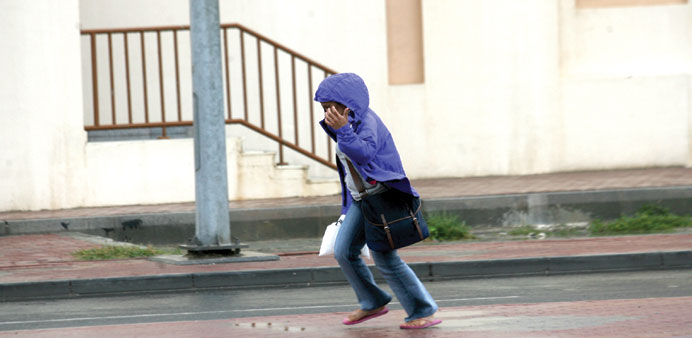WET SPELL: On an average year, Doha can expect around 13mm (5.1 inches) rain in January, but this year we’ve seen over 16mm (6.2 inches). Photograph: Nasar TK
By Steff Gaulter
It’s not been warm in Doha so far this year, in fact I’ve still got my heaters out. It feels so wrong to have my heater on when it’s only 13oC (55oF) outside, but while we were watching television, my husband and I started fighting over who the cat was going to sit on, and I realised it was time to switch on the heaters.
Obviously some people have been feeling the cold more than usual, because the other day someone asked me to confirm the rumour that it’s been the coldest January in Doha for a 100 years. It certainly hasn’t felt quite that cold to me, but it did prompt me to go and have a look at the average January temperatures of the past few years.
It turns out that January 2014 has been the coldest January since 2009. Given that January is the coldest month of the year, this means that only those of us who have lived in Doha for more than five years will have experienced such a prolonged spell of chilly weather.
However, whilst this month as a whole has been cool, we’ve not had any particularly cold snaps. At no point this month has the temperature dropped below 12oC (54oF). In January 2012, the temperatures in Doha dropped as low as 9oC (48oF), and at Al Udeid, the temperatures dropped as low as 4oC (39oF). Now that is properly cold!
As chilly as this was, it was actually far colder in other part of the Gulf. As the temperature dropped to single figures in Doha, the temperature in Baghdad plummeted to -1oC (30oF), in Riyadh it dropped to minus -2oC (28oF) and at Kuwait Airport it was rather a chilly plus 3oC (37oF). As well as being cold, the air was also incredibly dry, with humidity down to just 11% in Kuwait. Throughout the city people were reaching for their moisturiser!
Places to the north of us are usually far cooler than Doha. In January, our average daytime temperature is a fairly mild 21.7oC (71oF), but in Kuwait, it’s 19.5oC (67oF) and in Baghdad it’s 15.5oC (60oF). The night time temperatures make me feel cool just looking at them; in Doha it’s a relatively mild 13oC (55oF), where as in Kuwait it’s 8.5oC (47oF) and in Baghdad it’s a chilly 4oC (39oF).
It’s colder to the north of us, because the waters of the Gulf are generally quite mild. Our prevailing winds are from the northwest, and as the air passes over the Gulf, the waters warm up the air and add moisture to it. This means that by the time it arrives in Qatar, it has changed quite significantly, which is a relief for those of us living in a country that isn’t designed for cold weather.
Now we’re in February, the weather should start to warm up. There could still be some cold snaps in the first half of the month, but by the end of the month no one should be saying it’s cold any more. The average maximum temperature in February is 23oC (73oF), but by the end of the month the temperature could be soaring as high as 30oC (86oF).
There’s also likely to be some more rain. February is usually the wettest month of the year for Doha, with an average amount of 17mm (0.67 inches). Obviously if you compare Qatar’s weather to almost any other part of the world, it’s clearly still rather a dry month, but for Qatar it’s positively soaking!
To give you some idea of how much rain that would be, if there are 5-10mm (0.2 - 0.4 ins) of rain anywhere in the world, it would be described as a wet day.
The trouble is, as you probably know, the rainfall in Doha is quite hit and miss. Some years we seem to get a lot, and in others, we barely see a drop. So far this year, we’ve seen a fairly decent amount of rain. On an average year, Doha can expect around 13mm (5.1 inches) in January, but this year we’ve seen over 16mm (6.2 inches).
Unfortunately a wet January doesn’t bear any relation to what may happen during the rest of the year. Long-range forecasts still have a long way to go before we can rely on them, so all we can do is look at the average.
Based on this, we can expect some more rain and fog in February, as well as the occasional sandstorm. Great walls of sand usually come to us from the north, as a weather front loses its strength. Instead of rain, a collapsing weather system can just bring us wind and cloud, but this can be all that’s needed to form a dust storm.
Dust storms will always be my least favourite weather in Qatar. Often you can tell there’s a sandstorm without even looking out of the window in the morning, firstly because it’s darker than usual, as the sand is obscuring the sun, and secondly because you can actually taste the dust.
However much we might dislike them, sandstorms are one of those inevitable features of the weather if you live in a desert. This means we simply have to learn to live with them, and to be honest, if it’s a choice of the occasional sandstorm or the dark damp winter days of the UK, I think I’ll stay in Qatar!



